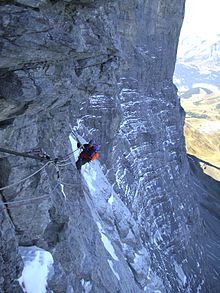
| Part of a series on |
| Climbing |
|---|
| Lists |
| Types of rock climbing |
| Types of mountaineering |
| Other types |
| Key actions |
| Key terms |
In climbing and mountaineering, a traverse is a section of a climbing route where the climber moves laterally (or horizontally), as opposed to in an upward direction. The term has broad application, and its use can range from describing a brief section of lateral movement on a pitch of a climbing route, to large multi-pitch climbing routes that almost entirely consist of lateral movement such as girdle traverses that span the entire rock face of a crag, to mountain traverses that span entire ridges connecting chains of mountain peaks.
Long traverses in rock climbing and alpine climbing may require additional climbing techniques (e.g. a pendulum or a tension traverse), and pieces of climbing equipment (e.g. ascenders) to manage the risks of the lead climber and/or the following climber falling far off the main route. Long traverses also place increased pressure on the abilities of the following climber than in a normal climb. Traversing is an even more regular feature in bouldering and is also a popular rock climbing training technique on indoor climbing walls.
Notable traverses include the 4,500-metre El Capitan Girdle Traverse on El Capitan, the world's longest rock climbing route;[a] the Hinterstoisser traverse on the Eiger, which was the key to the famous 1938 Heckmair Route; and the Fitz Roy traverses (both directions) of the Cerro Chaltén Group, which are considered some of the hardest 'mountain traverses' ever completed. Climbers consider the 'Everest-Lhotse traverse', and the even harder 'Everest-Lhotse-Nuptse traverse', as some of the unfinished "holy grails" of mountaineering.
Cite error: There are <ref group=lower-alpha> tags or {{efn}} templates on this page, but the references will not show without a {{reflist|group=lower-alpha}} template or {{notelist}} template (see the help page).